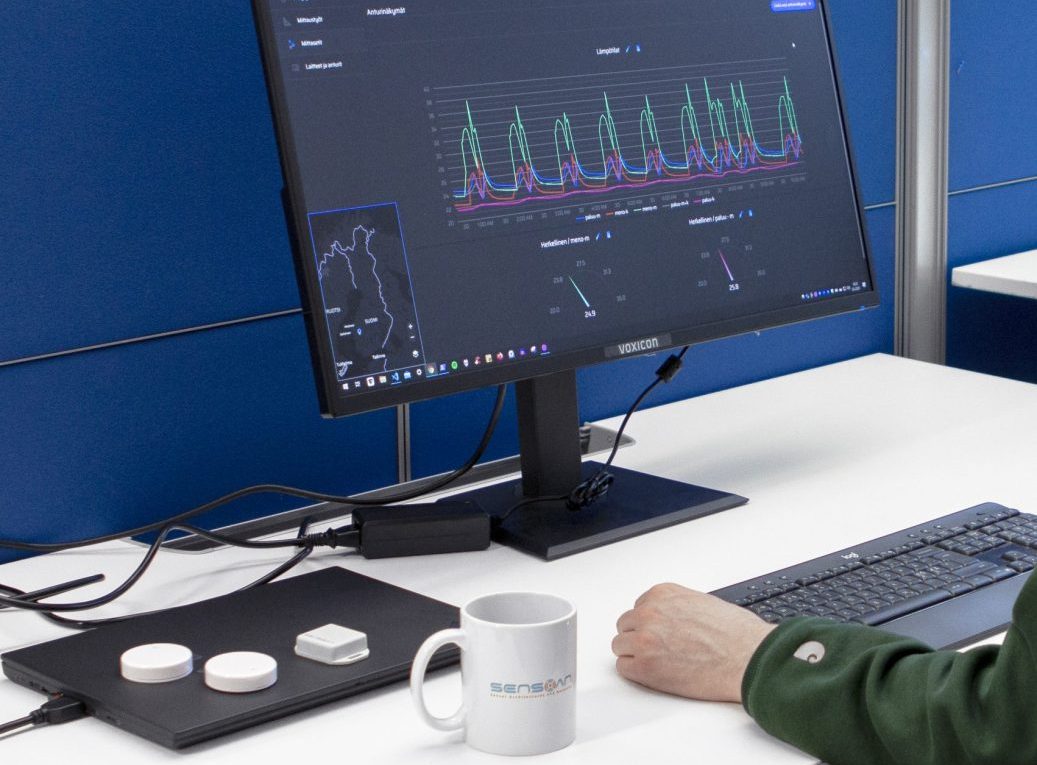- COMPANY /
SENSOAN (https://www.sensoan.com/ )
- SEMINAR’s focus
To explore the added value that IoT offer in mobility and energy industries.
- DESCRIPTION:
Sensoan Oy sells and develops IoT solutions for business customers. Sensoan developed solutions are used in various industries e.g. electric power distribution, power electronics, buildings, manufacturing, logistics and even in elderly care. Common for the use cases is the need to know what is ongoing at the (remote) premises and act based on that data. This can lead to considerable savings when e.g. maintenance at remote locations can be based on actual need instead of just relying on calendar based actions.
The solutions typically comprise of physical sensor devices with transmitting capabilities, cloud backend data processing and data visualization on web UI or mobile app. Sensoan can deliver the complete end-to-end solution but can also provide just the sensor solution or integrate it into an existing backend system. Besides the complete solution, key benefits Sensoan can offer are purpose optimized design of the sensors, long operating time for battery powered devices and state-of-the-art wireless connectivity.
Sensoan was founded in 2016 by a team of engineers with extensive experience in mobile device development. Since then Sensoan has delivered numerous tailored projects where customer requirements and satisfaction have always been in focus. In the recent surveys customers have especially appreciated our dedication and willingness to go the extra mile to solve their problems.
In the future Sensoan wants to build on the cumulative know-how in wireless device and cloud services development, so that it would be easier for more and more companies and businesses to join the IoT and digitalization movement.
- CHALLENGE:
The Internet of Things (IoT) has become an enormous part of how we live, work, and communicate together. Web-empowered gadgets are transforming our reality. From the benefits that IoT offers we can mention two examples:
- Reductions of operational costs. For example maintenance costs can be reduced with remote monitoring from scheduled maintenance to need-based maintenance. It means problems can be detected on-the-fly and can be fixed before they create a bigger impact in the business. Consequently it is possible to keep equipment and infrastructure functioning with efficiency.
- Access to critical information in real time. While monitoring remotely with IoT, it is possible to have access to certain information, which can’t be perceived through human senses and have an impact in different types of business and industries.
From the engineering and computer science perspective the IoT system consists of four distinct architectural elements: devices, gateways, cloud and apps. All these elements require special skills in their development. Furthermore experts should assure that the ecosystems are secure addressing aspects such as AI attacks, cloud attacks, lack of logging, data security and privacy issues. Consequently, today, there is not a standard IoT solution.

Despite the benefits of IoT for industry, its adoption is slow because the solutions need to be tailored. Nowadays, consumer perception has an important role in the decision to adopt services involving IoT. If businesses and consumers do not understand how their gadgets stay connected, how exactly their information is being used, and how it will benefit them, then consumers will not adopt IoT.
A hypothesis for this seminar session is: if we have the technical capabilities to solve all the vulnerabilities of an IoT system, then an important question to reflect upon is the added value that current industries gain if they embrace IoT. As current industries are a wide domain to narrow it down, we will focus on two types of industries: mobility and energy. Hence our reflections on this seminar session will focus on: What is the added value that IoT offers to mobility and energy industries? How does this added value benefit the mobility and energy industries?
- DAY and TIME:
Friday April 29th from 12 to 4 hrs.
- SEMINAR LOCATION:
UTU Agora building room 110C
- ENROLLMENT:
Please enroll to the session following this link: https://link.webropol.com/ep/sensoan22
Enrollment closes on Wednesday April 27 at 4pm.
- PRE-ASSIGNMENT
The deadline of this pre-assignment is Thursday April 28th at 4pm. To prepare ourselves for this seminar session let’s first relate to the context of this session.
Task 1.Understand IoT in from a Business to Business (B2B) perspective Probably all of us have heard about IoT, and our understanding of IoT might vary from deep knowledge to just hearing about the term. In this first task we want to assure that all of the participants have an understanding of IoT and how it is utilized in B2B contexts from your academic background. Hence, for this task explore literature from your academic background about IoT in a B2B context. Include a reference of the source you utilize to gain an understanding about IoT.
Task 2. Create a B2B product concept in the area of Mobility or Energy. From the previous task, you already have an understanding about IoT in B2B context. Now we start to ideate for this particular session by following five steps.
- Step 1. Select the industry you will ideate for between mobility or energy. If you need more information in order to select what industry you would like to focus on, then you explore more about the industries before you commit. The following articles might also give you some insights: Oliveria Cruz and Miranda Sarmento talks about Mobility as a Service, the paper of Hossein Motlagh et al focuses on IoT and the Energy Sector. You can also find other sources if you find them relevant.
- Step 2. Explore the industry you select. Once you select the industry you want to focus on, do some reflection upon it and research about its characteristics, e.g. How does it work? Who are the end users of that industry? Can you detect their current challenges? what innovation will they benefit from? Do they already have some IoT solutions? If yes, which ones? Are they already using IoT solutions? What IoT solutions are already available for this industry?
- Step 3. Identify a problem or an innovation where IoT would offer a solution or an added value for the industry you selected according to your finding in step 2.
- Step 4. Create your IoT concept addressing the problem or innovation in the industry you selected building upon your finding of previous steps. Aim to detect a solution that can have an impact in a short and long term, making it “realistic” to implement. Write down the description of your concept.
- Step 5. Based on your concept description, specify how the industry you selected benefits, and how the end-user of the industry you selected might experience your solution as well.
Task 3. Evaluate your concept
From Step 2 you have an IoT concept that benefits the industry you selected between energy or mobility, and you have thought about how end-users of the industry you selected will benefit from your concept. The final task focuses on “testing” your idea through 2 steps.
- Step 1. Write down 2 questions that will help you to evaluate your concept with the general public.
- Step 2. Detect 3 persons (e.g. friends, colleagues, family) to whom you will comment your idea and ask them the 2 questions you prepared to evaluate your concept.
REPORT
Please submit by Thursday April 28th at 4pm a report of your work. The report should include.
Task 1. A brief written description of your understanding about IoT in a B2B context.
Task 2. The answer to the five steps of this task: the selection of industry, understanding of the industry selected, the problem you will address, idea description and its perceived benefits.
- Step 1. Specify what industry you are focusing on ENERGY or MOBILITY
- Step 2. Write a brief description of the industry you selected. Include the findings of IoT solutions that this industry is already using.
- Step 3. State the problem or vision you detect that can be addressed with an IoT solution
- Step 4. Write the description of your IoT solution
- Step 5. From your solution (step 4) describe how end-users of the industry might benefit from it.
Task 3. A summary of the two steps of this task.
- Step 1. Write down the 2 questions you will use to evaluate your concept
- Step 2. Write a summary of the responses of the 3 persons you talk about your concept.
Submit your report, preferably a PDF file by Thursday April 28th at 4pm to Carolina Islas caisse [@] utu.fi with the subject line: SENSOAN pre-assignment.
Your file name should be: SENSOAN_pre-assignment_YOUR-NAME
If you have any questions please consult me.
